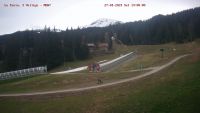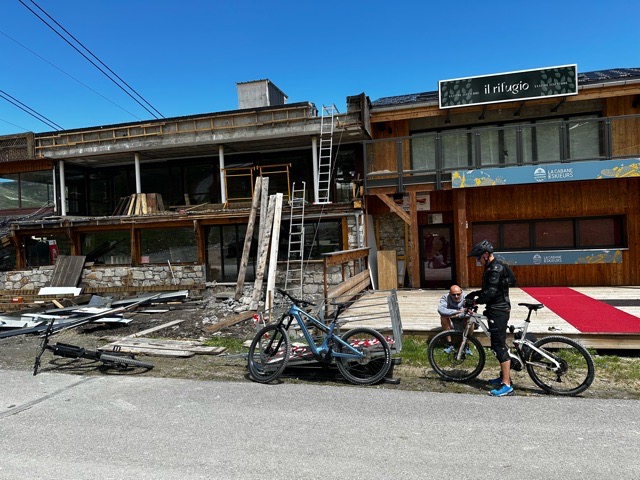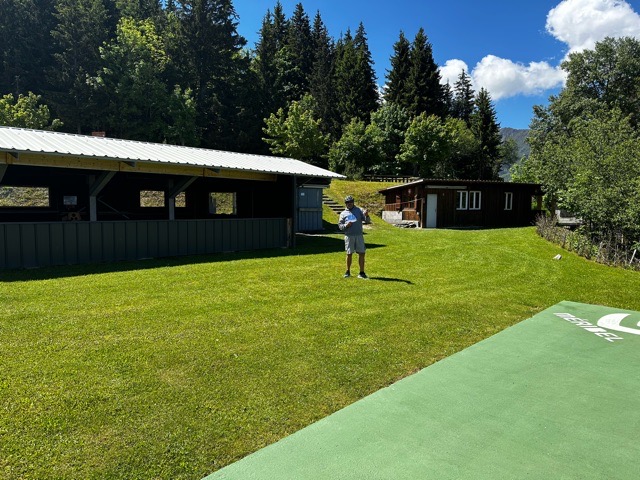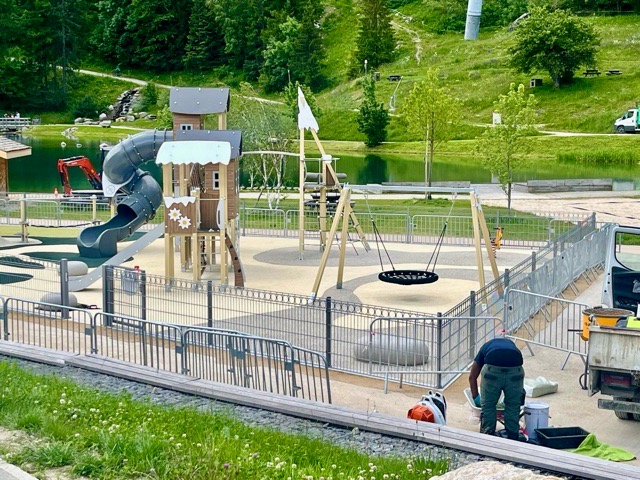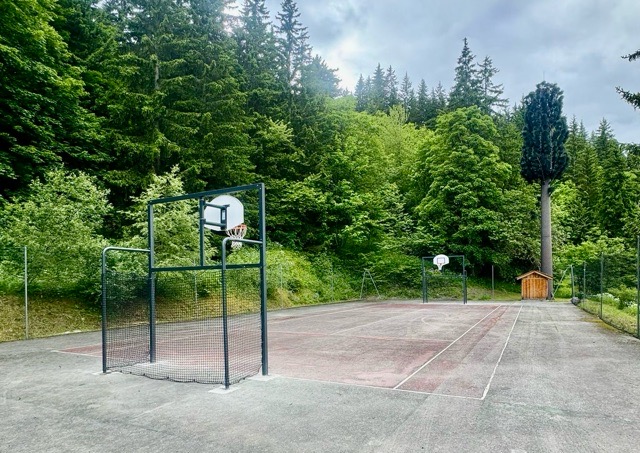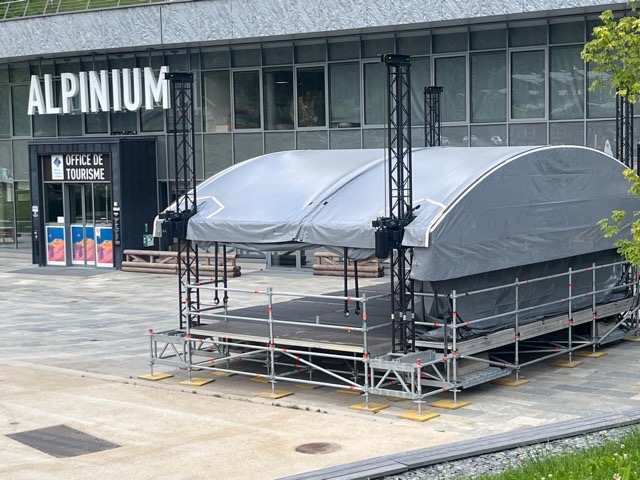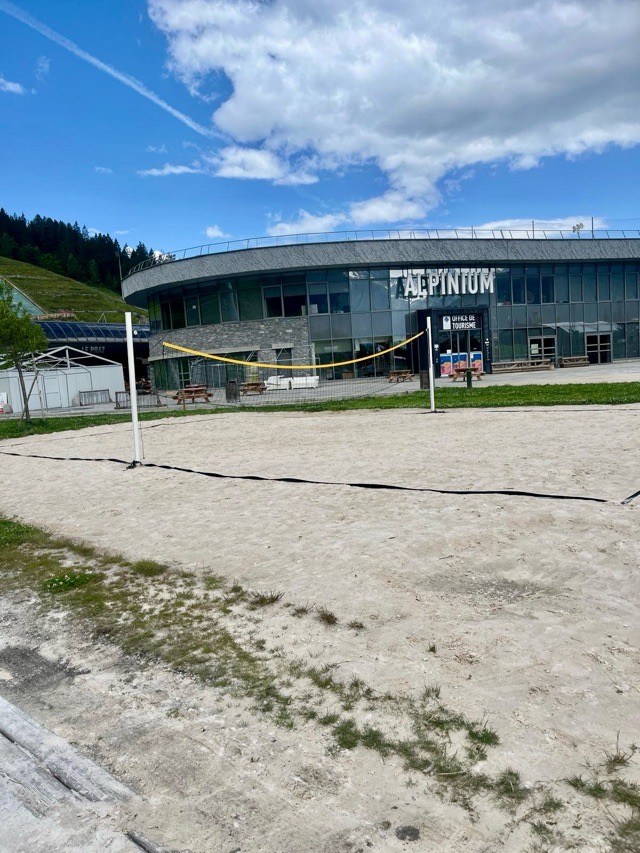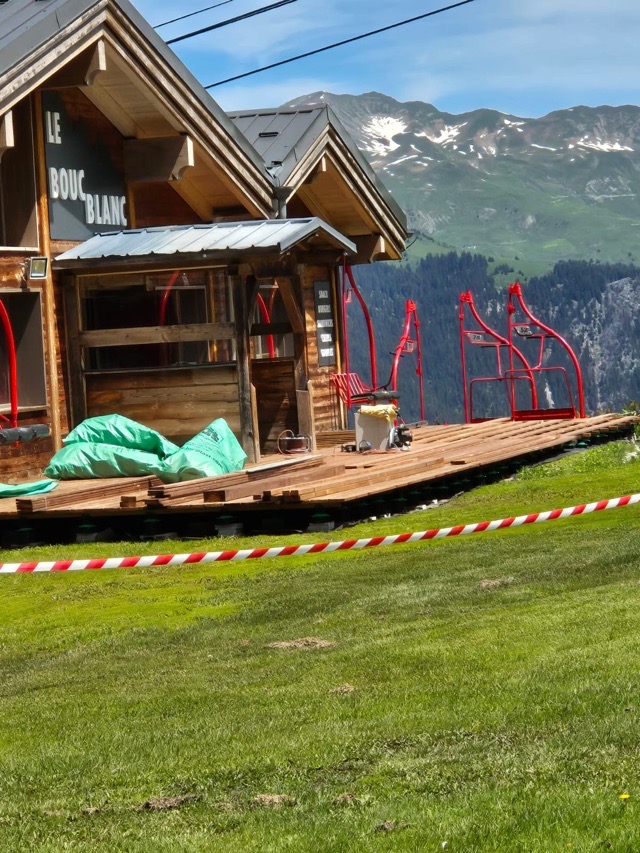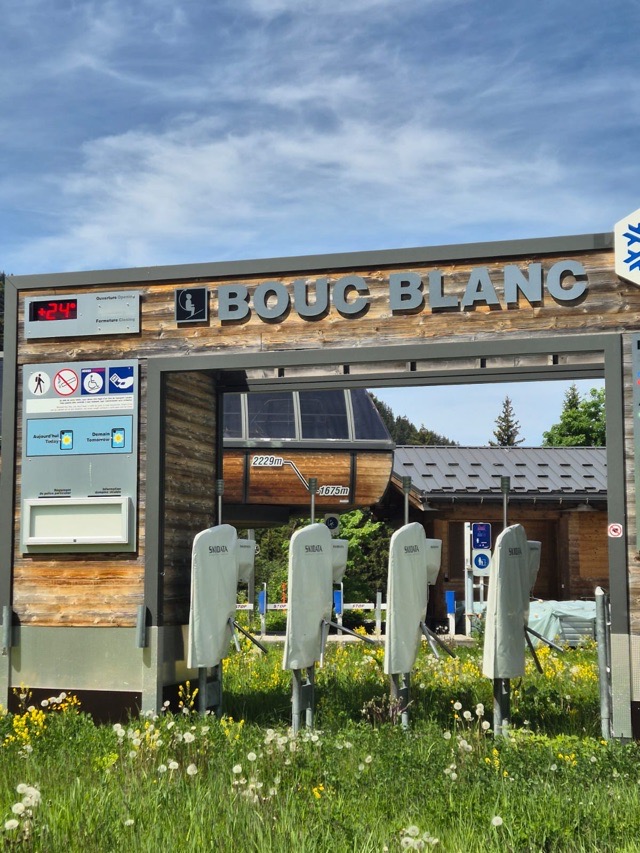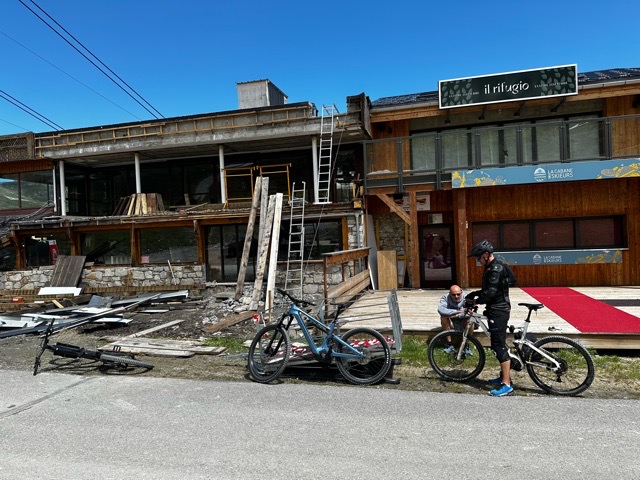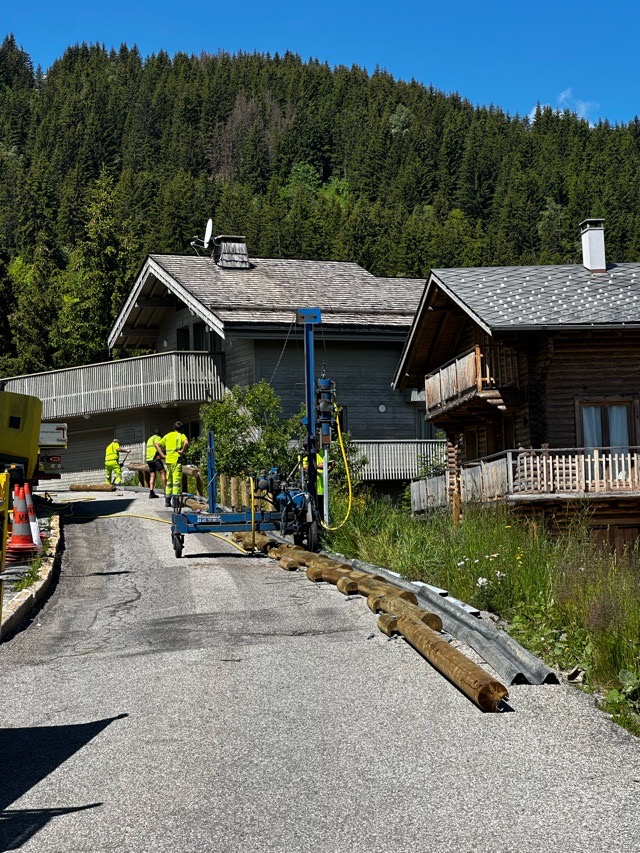The La Tania Ski Blog
Latest news, snow, pics, gossip and information from the locals in La Tania – latania.co.uk
All the latest news from around the Three Valleys from the La Tania locals. A real blog since 2006, not just endless re-posts for search engine optimisaton! Photos, gossip, snow reports, what's on and all the latest on the Apres Ski scene... Now fully optimised for iPhone, Touch and Android Mobiles - just go to latania.co.uk/blog and view on your phone. Our other past blogs & favourites here
First Time e-Bikers on Col de la Loze & New Management at Méribel Tennis Centre

e-Biking
Paul & Eddie at Col de Loze above La Tania on Scott e-Mountain Bikes hired from Le Petit Velo Rouge in Le Praz.
A full hire, servicing and repair service is offered by the very helpful Velo Rouge team who have a temporary “shop” outside the Alpinium Building next to the Lake in Le Praz. They give you a free one-way up voucher to the Praz gondola when you take out a bike too.
Lots of marked e-Bike (and downhill) tracks and trails with easy gravel paths, the tarmac over Col de la Loze (& Tougnette down to Les Menuires) and downhill full-on Mountain Bike maintained tracks graded accordingly with a few easy options too.
All the biking maps and guides on our Summer Life in La Tania page.
For those that really like to hammer their e-Bike batteries (or have an old one without a days capacity) please check on the availability of the chargers across the mountains – the one on Col de Loze is plugged in but the Bosch charger lead has been nicked and the one in Le Praz is not switched on. The Méribel Spa charger at 1600 is often un-plugged too – plug it in the socket near the roof to get a charge!
Tennis
Meanwhile the Méribel Tennis Centre is under new management with 2 friendly young French Lads running it. They’re having a doubles tournament every Wednesday throughout Summer and everyone is welcome.
To book a court and for further information email Adrien on adrien@tennisclubmeribel.com or WhatsApp on +33 660 22 90 22
To book the court in Le Praz or the Padel Tennis in St Bon use the on-line booking system at:
https://courchevel.simplybook.it/v2/#book/count/1/
Rackets and balls available from The Alpinium in Le Praz with a deposit.
Thanks to Ralph at The Freeride Republic for the pics.
3 Highly Enjoyable But Lesser-Known Winter Sports You Must Try
When you visit La Tania, you will no doubt have a packed schedule of skiing and snowboarding in mind. Yet there are other sports played in winter, both here and around the world, that are lesser known. Many of them are extremely fun and well worth your time. Below, we discuss three highly enjoyable winter sports you must try.
Skijoring
Winter sports are hugely popular across the world, and they have been used across various entertainment mediums because of this. You can find them in movies, on your favourite streaming services and even in online slots games. Here, games such as Pure Puck Lucky Tap, a hockey themed title, have been used alongside free casino bets to invite new players who also like winter sports into the world of slots.
Skijoring is a highly enjoyable sport that can not be that far from inclusion in the Winter Olympics. This is because it is just so much fun to watch. It is a winter sport that is a cross between dogsledding and waterskiing. A person straps on skis and is pulled by dogs, a horse, or even a motor vehicle. The sport has its origins in the Sami people, who would use it as a way to travel vast, snowy expanses. It was even included in the Stockholm Nordic Games at the start of the 20th century and was an exhibition sport at the 1928 Winter Olympics.
Bandy
Ice Hockey is another hugely popular winter sport. The NHL is the worlds biggest league, and as of 22/07/2024 the Florida Panthers are 5/1 to win the Eastern Conference. You can bet now on this online, before the Stanley Cup takes place and odds may change. While this is the biggest league, there are plenty of variations of the sport, one of which is Bandy.
Bandy is an amalgamation of several games, though none knows where it quite originated. The rules were first published in England in 1882, but it is unlikely to have come from here due to its requirements. The game needs a large, icy playing field, much like a football pitch. However, this would require a frozen lake, the likes of which seldom appear in Britain due to its climate. Its rules are a cross between ice hockey and shinty, an Irish game like hockey. It is played withsticks, and two teams must skate across the ice and get the ball into the opposing goal. It is very popular in Sweden and Russia.
Yukigassen
Yukigassen is essentially a huge snowball fight with rules. Hailing from Japan, Yuki translates as snow and “gassen” means battle. It pits two teams of seven players each against each other. Players are eliminated when hit by a snowball, and their team must attempt to capture a flag. Tournaments take place across the world, from Russia to Armenia, with each following the rules set out by the official Japan Yukigassen Federation.
There are plenty of other obscure winter sports that are worth trying out. Some of them, such as skeleton, even make it to the Winter Olympics. Ask about these at tourist information points when you go on your ski holiday, and you may just get to join a snowball battle or even ski across the snow while pulled by a dog.
How to prepare for a trip to the mountains
Embarking on a journey to the mountains is an exhilarating experience, promising stunning landscapes, fresh air, and a break from the hustle and bustle of daily life. However, preparation is key to ensuring a safe and enjoyable trip. From understanding how electric car coolers work to preparing your vehicle and packing the essentials, this guide covers all you need to know to get ready for your mountain adventure.
Understanding how electric car coolers work
For travelers seeking to keep their food and beverages fresh without the need for ice packs, an electric car cooler might be the perfect choice. Electric car coolers work by utilizing the car’s electrical system, typically connecting through the 12-volt DC outlet (commonly known as the car cigarette lighter). Inside the cooler, a thermoelectric module uses the Peltier effect to create a temperature differential, effectively cooling the interior of the cooler.
This system is advantageous because it does not require ice, which can melt and create a mess. Additionally, many electric car coolers come with temperature controls, allowing users to set the desired cooling level. Some advanced models even offer dual functionality, with compartments for both cooling and warming, making them versatile for various needs. The convenience and efficiency of electric car coolers make them an excellent addition to any mountain trip, ensuring that food and drinks remain at the perfect temperature throughout the journey.
Preparing your vehicle for mountain travel
Preparing your vehicle for a trip to the mountains involves several crucial steps to ensure safety and reliability. The first step is a thorough inspection of your vehicle’s mechanical condition. This includes checking the brakes, tires, engine oil, coolant levels, and battery. Mountain roads can be steep and winding, demanding more from your vehicle’s braking system and engine. Ensuring that your brakes are in good condition and your tires have adequate tread and are properly inflated is essential for safe driving.
Additionally, it’s wise to check the weather forecast and understand the potential for extreme conditions. Equip your car with all-weather or winter tires if you expect snow or ice. It’s also beneficial to have your vehicle’s transmission and suspension inspected, as these components can be heavily taxed on rugged mountain roads.
Bringing an emergency kit is another crucial aspect of preparation. This kit should include a first-aid kit, flashlight, extra batteries, blankets, a multi-tool, and non-perishable food items. Also, carry extra water and a car charger for your phone. It’s advisable to have a set of tire chains, especially if traveling in areas prone to heavy snowfall. Lastly, ensure your GPS or navigation system is up-to-date, as mountain areas can sometimes lack clear signage or cell service.
What to bring in your car for a mountain trip
When packing for a mountain trip, it’s essential to bring items that cater to both comfort and safety. Start with clothing: pack in layers to accommodate the varying temperatures you might encounter in the mountains. Include base layers, insulating layers like fleece or down jackets, and waterproof outer layers. Good quality hiking boots are a must, along with extra pairs of socks and gloves.
For personal care, bring sunscreen, lip balm, and sunglasses, as UV rays can be stronger at higher altitudes. A hat and a sturdy backpack are also essential for day trips or hikes. Don’t forget a reusable water bottle to stay hydrated and a portable water filter or purification tablets if you plan to source water from natural bodies.
It’s also wise to pack a detailed map of the area you will be visiting, as GPS devices can sometimes fail in remote regions. A portable charger or power bank for your electronic devices ensures that you stay connected and your gadgets remain operational.
The best things to take on a mountain trip
When considering what to take on your mountain trip, prioritize items that enhance both enjoyment and safety. Outdoor gear such as trekking poles, a tent, sleeping bags, and a camping stove are invaluable for extended stays in the mountains. Ensure you have a durable and spacious backpack to carry your essentials during hikes.
A high-quality camera or smartphone with a good camera is a must for capturing the breathtaking scenery. Bring binoculars for wildlife spotting, and a journal or sketchbook if you enjoy documenting your adventures.
For nutrition, pack a mix of non-perishable food items like nuts, dried fruit, energy bars, and instant meals. A portable cooler, preferably an electric car cooler, is excellent for keeping perishables fresh.
Entertainment is also important; bring books, a deck of cards, or portable board games for downtime. Lastly, always carry a small repair kit for your gear, including duct tape, a sewing kit, and spare parts for any equipment.
In conclusion, a well-prepared mountain trip involves careful planning and thoughtful packing. By understanding the workings of electric car coolers, preparing your vehicle meticulously, and packing the right items, you can ensure a memorable and safe adventure in the mountains. Happy travels!
Information taken from sources:
Types of car refrigerators autodoc.co.uk
About the car’s readiness for traveling to the mountains
New Volley Ball Court, Play Area & Stage in Le Praz, Verdons Refurb and Barriers in La Tania

Le Praz has its newly refurbished tennis court, play area, volley ball court and a stage near the Alpinium Building.
The restaurant at the base of the cable car station is being refurbed (possibly with a matching balcony to the Italian place next door). The Saulire Cable Car is finally going to re-open this December.
Meanwhile La Tania has some new lovely wooded road barriers up to the chalet area and the multi- sports nets on the old tennis court.
The Ball Trap (clay pigeon shooting) area is open between La Tania & Méribel Village and is looking immaculate.
Paths have been prepared and grass cut, extended decking at Le Bouc Blanc and a weird barrier on a pedestrian crossing too!
The free Pool table is back in the Ski Lodge, information on the La Tania Outdoor (heated) Pool to follow.
Must-known tips that will make your skiing experience more fun
Since you’re reading this, you may have come to the conclusion that skiing is a thrilling mountain activity to try. That’s for sure, but what if we told you that you get some immeasurable benefits when taking powder turns through a tree run? That’s right skiing is a workout for both the body and the brain and can improve your quality of life immensely. In fact, studies have concluded that skiing, when performed regularly, can play a role in healthy ageing because it involves high levels of physical activity and since it’s such an adaptable sport, you can do it regardless of your age, which is what makes it so fascinating.
Besides, skiing can give you mental stability, and make you feel more grounded, serving as a great coping method for the times when you’re dealing with stress and anxiety. And the best part? It’s genuinely fun! Perhaps you’ve tried skiing two times and if that’s the case, know that you’ve done this activity more than 83% of people – and now you’re here because you’re planning to take a trip to the mountains and want to make your skiing experience more enjoyable and memorable. If that’s the case, you’ve come to the right place because in what follows, we will provide some tricks to get your groove on the slopes. Let’s begin!
Take ski lessons
It may sound like a no-brainer, but if you’re a ski newbie, it makes sense to take ski lessons. You wouldn’t want to waste the day laying on the snow when you’re in the mountains, right? Luckily, you can get help from a professional ski instructor, who will teach you how to master skiing techniques and have fun on the slopes.
Suppose you’re an experienced skier; it’s still wise to take a lesson because it can help improve your skills, maybe you have a bad habit that hinders your enjoyment, and if that’s the case, a professional will help you fix the problem and ensure you will have the time of your life while skiing.
Let the music play
Here’s an excellent way to have more fun while skiing: turn on your favourite songs! Yes, you’ve read that correctly! Listening to music while skiing can keep you energised and enhance your experience. If you consider it for a while, skiing and dancing are very similar both require you to bend your knees and twist your hips, so why not combine them for a magical time on the trail?
Besides, when you listen to your favourite music while skiing, you will reminisce about those good times whenever you hear the songs again, doesn’t that sound incredible?
Stay warm and comfortable
Is it possible to stay warm all day when going to the mountains? Yes, and if it’s not the case for you, that’s because you aren’t wearing the right clothes. Firstly, you should never wear cotton, mainly if you go skiing in a wet climate, as it traps moisture and sweat, which means you can easily catch a cold.
Secondly, you should choose a base layer (like wool or synthetic material), add an insulating layer, such as a fleece sweater, and then a windproof or waterproof layer. And of course, you should also cover your neck. Finally, thin socks are a must when it comes to your skiing wardrobe because if they are too thick, you will feel like you’re losing control of your ski boot, affecting your blood flow. These tips should help you feel more comfortable and warmer when skiing, but don’t forget that if you still feel cold, you can always take a hot cocoa break!
Bring your friends with you
An experience is always more fun and memorable when you share it with others, and things are no different when it comes to skiing. So, ask your friends if they want to join you while skiing. Think of having a friendly competition or simply enjoying the time you spend together while on the slopes.
Besides, mountain trips are more fun in general when you bring friends with you for many reasons. For instance, you may plan a road trip to the mountain, but it could take a few hours to get to the destination by car. But travelling in a group can solve that problem because that friend with a great sense of humour will keep everyone entertained! Just be sure to prioritise safety on the road, and avoid accidents from occurring. According to https://www.personalinjuryclaimsuk.org.uk/, every driver has a duty of care which defines their conduct on the road, and it’s essential to follow it to avoid distressing events that could cause injury or, worst-case scenario, be fatal. While your goal is to have fun, remember that nothing is more important than ensuring everyone is safe.
Make sure you have proper equipment
If you’re still relying on the skis your mum got before you were born, it’s clear that you cannot have fun while skiing! While they may work the first time you’re out sliding, when you master new techniques, it makes sense to rent another piece of equipment or buy your own set of skis.
Having a good day starts with having the right gear! While it can be challenging to buy proper equipment, there’s something out there for everyone, and if you take the time to reach out, you will find a set that suits your own style, goals, and budget. Remember, nothing can stop you from having a great day in the mountains!
The bottom line
While it’s true that skiing comes with many benefits, the main reason you probably want to be on the slopes is that you want to forget about your worries for a while and have some fun. Luckily, with the tips above, you can make that a reality, and have an experience you won’t forget! Bring your friends with you, stay cosy, push your limits if you want, and don’t forget to take breaks when needed while skiing can be lots of fun, it’s also a good idea to stop and enjoy the breathtaking mountain scenery! Happy skiing!
ESCAPADE 2024: Greig Lloyd, Paul Aitken and Adam Hemming

03 February 2025
Better late than never…
Having had an unsuccessful attempt in 2023 (black run in Orelle being an icy mogul field, plus a snowboarder in our midst) we gave it another go in 2024.
Starting at Pointe De La Masse in Les Menuires with the first lift up and ending on Bettex with 6 minutes to spare. It was a fabulous day where the weather and queues were all kind and we made it to the end together!
Could not recommend the day highly enough and the beers certainly flowed at the end.
Looking for another challenge now for next season.
Greig, Paul & Adam
ESCAPADE 2024 – What’s this all about…
The 3 Valleys Escapade was the lift company promotion of visiting (originally in 2006) 14 points across the Three Valleys and gaining a certificate & badge over the period of your holiday – doing it in a day was a bit tricky though!
It all started out as a late night “is it possible?” discussion – the history and our original route from 2006 are here
Originally punch cards had to be stamped at each check point until electronic passes arrived and then the use of a lift was recorded – now we use Apps such as Ski Tracks or Relive to prove our route.
Note that the Escapade is no longer officially promoted by Les 3 Vallees from Winter 2017 but we still record successful tracks for anyone who is interested in being in the sought after La Tania Escapade Hall of Fame
The original Escapade took 30 lifts, around 13000m vertical with 70km length and by 2016 reached 34 lifts, 17000m vertical (twice the height of Everest) and around 80km skiing (140km total distance). With the newer, longer, faster lifts we’re back down to 30 lifts and the age range for successful completion is from 8 to 76 years old! The latest ESCAPADE route
This is NOT a race
ALWAYS CONTROL YOUR SPEED. You do this entirely at your own risk, act responsibly, take full ownership for your own actions and all of those with you, respect other people (& the mountain), ski & ride within your limits, always obey the skiers & snowboarders code, observe all signs, pay attention to all notices, advice & instructions from Pisteurs, only ski off piste if fully equipped & knowledgeable, it’s not a race (you won’t be insured), think about the safety of others as well as yourself but above all, think of other people, take care, don’t wreck things for others & don’t even think of blaming anyone else if it all goes wrong…..
Changes through the years
2006 – First year and cards with hole punches stationed at lifties huts are used.
2008 – Electronic lift analysis is now used – no use hiking out the 4th Valley now!
2010 – The piste map did not include the top of the 4th Valley and the Col lift in Val Thorens.
2011 – The X-Wing Discovery was launched but only had 10 check points and doesn’t count!
2012 – Peclet included and Biollay / Vizelle used for Saulire access.
2015 – Foret used instead of La Tania gondola.
2016 – Mont Vallon is included for the first time plus the Montaulever drag lift.
2017 – Chapelets replaced by Petite Boss drag and La Tania’s Bouc Blanc chair replaces Tovets.
2018 – The new Roc de Tougne chair replaces the drag lift of the same name.
2019 – Legends replaces Roc de Fer and the Montaulever drag in Les Menuires has been removed.
2020 – Cime Caron now back in use.
2022 – New Pointe de la Masse and Orelle-Caron Gondolas (for example) could be used.
2023 – Using the new lifts, we ski all the resorts, all the perimeters and classic peaks – ESCAPADE 2023
2024 – No changes to 2023 route!
What to do after ski injury in your lower body, the most exposed region to ACL
The knees bear the brunt of any skiing accident. Being the most abused body part when sliding on the slopes, this sport is not kind to your knees, which is a fact you come to terms with in the pursuit of the snowboard’s adrenaline.
Numerous studies point to the outer knee as the body region most harmed when skiing, with 43% to 77% of injuries occurring there. Youngsters are not spared by this truth either. In fact, grade 3 ligament traumas and knee sprains represent between 39% and 77% of ski injuries in adolescents and children. And if we were to risk money on the most common injuries, those would be as follows: an anterior cruciate ligament (ACL), a medial collateral ligament (MCL), and meniscus tears. Or, the damage could be a combo of these three simultaneously.
Whether you catch an edge or pivot, you must deeply understand the types of knee injuries to determine your specific case and know the steps you must undertake after such an unprecedented mishap. Here, we’re addressing the most common injury and recovery facts associated with damaged lower bodies in both competitive and recreational skiing. You will be equipped with expert-approved tips and the necessary knowledge to deal with such possible accidents with a clear and calm mind and vision.
Determine who’s at fault
The situations in which you must bear the responsibility for your slope accident are pretty straightforward to grasp. For instance, you could fail to change your direction properly when avoiding a tree and fall sideways. However, numerous accidents occur due to someone else’s fault, and even if it seems daunting to point fingers at first, successfully separating the wheat from the chaff will save you a lot of trouble later. Whether you’re involved in a collision with another skier or fall due to uneven snow on the ski resort’s slope, the truth is that determining who’s liable for your injuries isn’t that straightforward.
Ski resorts could go on admitting that you’re at fault for your accident, while slope participants could argue that you failed to avoid them as you needed. Numerous times, innocent skiers endure accidents caused by faulty gear, poor inspections, or dangerously prepared terrain where the ski resort is at fault for failing to keep users safe. The truth is that when conflicts arise and the innocent party is wrongfully found guilty, the best thing one can do is reach out to a seasoned lawyer to do justice to the guiltless. This is, even more, the case when ski resorts are involved, for they have experienced lawyers who generally back them and do all that’s in their power to come out clean, even if it means abusing liability waivers.
Stay ahead of the curve and make justice for yourself if you’re ever unlawfully blamed for accidents, no matter their causes or types.
The most common skiing-specific knee injuries
Skiing, despite triggering dopamine production in a way that not many sports do, brings a range of risks for your knees. Here’s your roundup of the common forms of knee injuries to build your essential knowledge, mainly if you’ll deal with skiers or entities who won’t own up to their mistakes.
1. Anterior cruciate ligament injuries most commonly occur when you change the speed or direction abruptly, land a jump incorrectly, or pivot
2. Medial collateral ligament injuries take place in collisions or falls most frequently, as your knee gets pushed inwards and can range from a strain to a definite tear.
3. Meniscal tears typically happen when weight suppresses your knee while it twists, leading to pain, impossibility of bending your knee painlessly, and swelling.
4. Fractures of the kneecap, also known as patella, can result from falls’ direct impact on your knee.
5. Tibial plateau fractures affect the upper region, alias shinbone, and commonly occur in high-impact falls and crashes, possibly leading to grave cartilage and ligament damage.
6. Poster cruciate ligament injuries aren’t that frequent, but while they’re still a probability, they’re usually not compelling you to reside. Studies show that from 53% to 88% of TPF victims get back on the slope after recovery.
Now, focus on your ACL recovery
If you’ve witnessed a noisy pop or popping feeling in your knee, followed by swelling and pain or the impossibility to keep skiing, you may have torn your ACL. Since this is the most common knee injury incurred by skiers, it’s important to determine whether you need an X-ray. This procedure isn’t sufficiently sensitive to disclose soft tissue affections, but some hints are discoverable this way. Plus, if you have a fracture, your physician will spot it and recommend the proper follow-up treatment. Moreover, they’ll establish if you need an MRI, the best test to instantly disclose the ACL and its consequences, enabling your physician to determine the full extent of the damage.
It’s recommended to contact the ski patrol or get any other type of assistance as soon as you feel something is wrong. Numerous patients fail to report the impact, postponing the healing process and the moment they return to their skyboards.
Lastly, ACL victims may sometimes need surgery, depending on the gravity of their trauma and the assessment of the physician (or, by case, the surgeon). While a few specific tears can pass with some physical therapy, if the ligament is completely ruptured, you may not be able to bypass the surgery.
Seek treatment
After any injury, you may feel like brushing it off with some reassurance expressed through words. However, the best you can do to ensure a smooth recovery and safe return is to get your injury assessed to prevent additional damage. An injury may not be caused entirely by a single mishap, but by numerous consecutive strains, poor skiing techniques, and so on. Whether it’s a knee pop, stiffness, swelling, soreness, or lower back pain, these red flags mean that you must be professionally checked to ensure your correct recovery.
Worst-case scenario, you’ll need surgery before returning to the slopes.
In some situations, like knee replacement surgery, which is among the worst you can experience, you may need to sit on the fence for a few months, while recovery can take up to a year. Generally, the things you will do after receiving the green light from a surgeon or physician involve:
- Placing pain-relieving ice compresses on your knee.
- Elevating it a few times a day.
- Undergoing incision care thoroughly.
Home exercises are recommended in most situations, and fortunately, they’ll help you recover faster and better, helping you get back on your snowboard when it’s completely safe to do so.
7 Exciting Activities on the Mountains for When You’re Not Skiing
A trip to the mountains for a skiing adventure is going to encompass a lot more than just strapping on the skis and hitting the slopes. There will be plenty of skiing downtime involved with the trip, which provides a chance to explore other exciting activities.
There is so much to do at these remote locations, so they are a perfect destination even for non-skiers. Renting a cabin at high altitude in a winter wonderland can be as much of a getaway as hitting a beach somewhere in the tropics.
Regardless of why you are on the mountain in the first place, there are plenty of exciting activities around to explore, from catching up on your latest reading list to playing casino games or engaging in more physically adventurous endeavours like sledging—there’s so much non-skiing stuff to do that those skis may even become a side piece of the trip.
Alternative Winter Activities
Just because you may be located at a ski resort, it doesn’t mean that that is going to be the only discipline of winter sports available. A good use of time between skiing adventures can be switching over to other winter activities, allowing you to pick up handy skills to use for future trips.
One of the most popular is undertaking long hikes through the winter landscape with snowshoeing—a great opportunity to take things at a slower pace while absorbing the fresh air and scenery.
Other alternatives to skiing include ice skating, dog sledging, snow tubing, and one of the newer winter resort phenomena, fat biking. Fat bikes use wide tyres that are only inflated to a low pressure, like 5 PSI, and those are perfect for cruising through soft, snowy terrain.
Hot Springs Visit
Many ski resorts have hot springs located nearby, which are worth taking time out to visit. This is one of the most ideal non-skiing activities to undertake because it is a wonderful opportunity to soak those muscles that have been through rigorous tests on the slopes.
Natural hot springs are things of beauty and provide a glorious post-ski soak. The alternative would be to jump into a resort hot tub, but that doesn’t quite hit the same mark as nature doing its thing. Just check first whether the hot springs are family-friendly, as not all are.
Exploring Towns
The exploration of towns in the immediate area of the resort provides a good getaway. The more immediate towns are likely to be heavily tourist-oriented, so it could be worth looking a little further afield on the map to soak up some actual local culture. Regardless, these are charming areas where food and drink can be absorbed, while still offering the excitement of dipping in and out of stores and catching some Instagram-worthy picks of the mountains in the background.
Photography
A ski resort is a photographer’s playground too, as a trip up the mountain proves a great opportunity to take a different look at the surroundings. Dive behind the lens and learn how to either perfect your photography skills in such a glorious location or explore the fun of photography from an amateur perspective for the first time. This will remove you from the world of mobile phones and their many distractions, plus it will provide higher-quality, unique mementoes of the trip.
Gambling
Relaxation could come in the form of gaming and gambling. Perhaps spending an evening in front of the fire pit after a long day on the slopes, nursing a cup of hot cocoa and loading up some gaming, could offer an exciting way to end the day. Depending on the ski resort, there could be a physical casino location on site. But Wi-Fi and, in many cases, strong phone connections are typically still available.
So, time can be spent dipping into some MMORPG action, spinning the slots, or getting into a live dealer game of blackjack at an online casino. Just stick to licensed sites for player protection, and it’s advisable to set up an account somewhere beforehand in private so that accounts are already funded to prevent fumbling around trying to reload payments in public.
The Adrenaline Rush
A giant snowball fight under the midway sun between friends and even guests who are unknown to each other could be an awesome, fun way to spend a little time. The bigger the snowball fight, the better!
While other traditional snow pastimes like snow angels and catching snowflakes are short-term blasts of fun, there are greater adrenaline rushes out there when not skiing. As you’llalready be embedded in the adrenaline rush zone, there may be further opportunities to top up the thrills of the trip. Look around the area for things like bungee jumping, ice-climbing, helicopter trips around the region, and jet-skiing.
Adventure Parks
Another thing to look out for while not skiing is adventure parks. These could be embedded within the resort or may require a small jaunt to a new location, but they can provide hours of entertainment. Adventure parks typically include things like climbing walls, zip-lining, and tubing courses. These are a little more fun-oriented and add great variety to a trip.
While there are plenty of things to do on the mountain, remember to also enjoy the quiet times, and the bliss and peace that come from such surroundings.
Ex La Tania Resident Band The Feeling Still At It!

After 19 years as The Feeling (and several as Superfly before that) with their 7th studio album just released, their UK tour hit Newcastle University last night.
They played all the hits – possibly 8 tracks from their first album 12 Stops and Home – plus a little bit of new stuff including the thought inspiring Foul Weather Friend and of course the headline track from the musical Jamie.
Stand-out tunes for us were Rosie, Never Be Lonely and of course Love it When You Call. And yes, they still encore with Video Killed The Radio Star!
Thanks Dan, Rich, Kev, Ciaran and Paul – about time you returned to the Ski Lodge for a gig (or the Sweat Lodge as you named it – before the air conditioning was installed!).










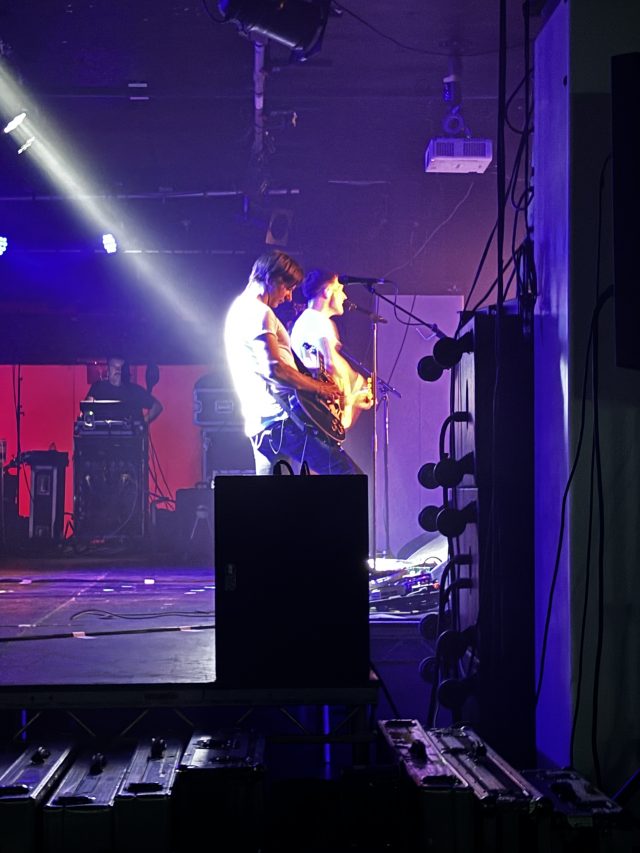
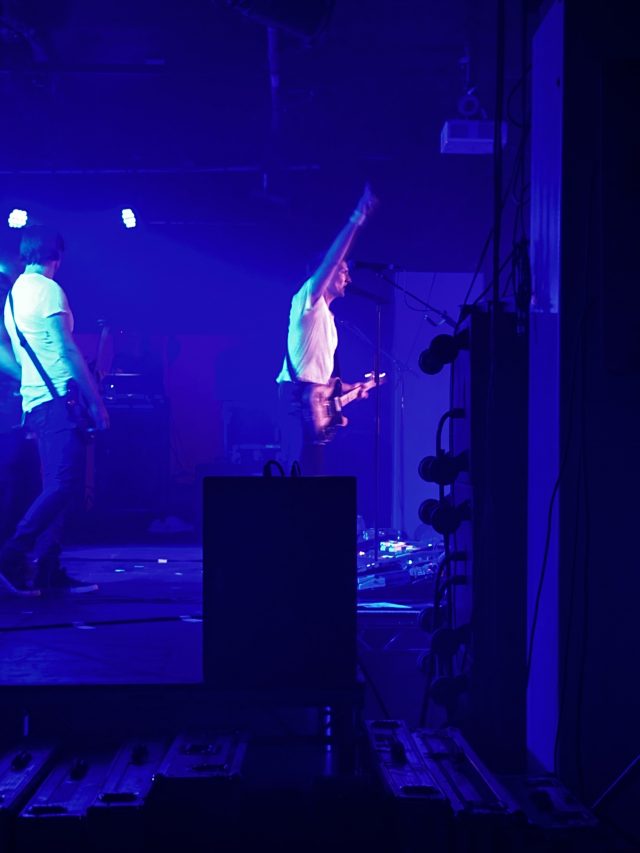
Keeping your data and devices safe when you’re out and about
There’s no denying that as a society, we have become increasingly reliant on technology in our daily lives, and this reliance is also noticeable when travelling. We now have smartphones, tablets, and wearables as essential travel companions, and use myriad apps and tech services to make our way through the world.
If you find yourself lost in the labyrinthine streets of an unfamiliar city, you can use your smartphone’s GPS to find your way and get to your destination. If the language barrier is giving you a headache, apps like Google Translate can come to the rescue. As for immortalising memories, new generation smartphones have incredibly performant cameras so you can document every second of your travel adventure.
Seen from this perspective, technology has certainly made travel easier, more convenient and enjoyable, and we can only be grateful for the benefits it provides. However, recognizing the advantages doesn’t mean ignoring the drawbacks.
Tech travel dangers
When you step away from the safety of your home network and use your smart devices on the go, you inevitably become exposed to a series of new risks and challenges, some of which you may not even be aware of. Besides, the thrill and excitement of discovering new places can make you more carless and therefore a more vulnerable target for thieves and cybercriminals alike.
It’s fairly common for gadgets like phones and tablets to get lost or stolen in the hustle and bustle of going from one place to another, exchanging planes and other means of transport, passing through crowds, and so on.
But what’s even more concerning is that your personal data can fall into the wrong hands. Apart from completely ruining your travel experience, having your data leaked or stolen can lead to an endless number of problems, as you can learn at https://www.databreachclaims.org.uk. With data breaches on the rise all across the world, this is a serious matter to keep in mind while travelling.
So, if you want to enjoy peace of mind and make the most of your outings, while also benefiting from all the perks technology provides, you need to take some precautions and ensure your sensitive information and gadgets are safe at all times.
Solutions to consider
Although all countries have rules and regulations in place to ensure both the digital and physical wellbeing of residents and visitors, you can’t rely entirely on different entities and organisations to keep you and your gadgets safe. It’s also your responsibility to protect yourself against unpleasant surprises, so here’s what you can do.
Set up strong passwords
Not using a password to lock your smart devices is like handing out an open invitation to prying individuals and criminals to take advantage of this security gap. Since most people have their whole lives on their phones, if a malicious entity were to gain access to all the information they hold, it could lead to irreparable damages. That’s why setting up strong passwords on all the devices you take with you during your travels should be your first concern.
Similarly, you need to protect all your accounts with strong passwords, made of a sequence of letters, symbols, and numbers, and ideally create unique passwords for each account to limit damages in case one of them gets compromised.
Use two-factor authentication
While passwords provide a good first line of defence, it’s important to keep in mind that hackers these days have become increasingly shrewd and refine their skills constantly, so you also have to up your cybersecurity game. Two-factor or multifactor authentication on your devices is a good solution in this respect as it adds an extra layer of security, so if hackers break your passwords, they still won’t be able to reach their goal.
Backup your data
All sorts of unexpected things can occur when you’re out and about, and your devices can get lost or damaged. In case this happens, you want to make sure you can still gain access to the data you had stored on them. That’s where data backups come into play. By backing up your data regularly, you make sure that all your important files and information are stored safely and you won’t lose them in case your devices stop functioning or go missing.
Use a strong antivirus
Some countries are more dangerous than others in terms of cybersecurity risks, so installing a strong antivirus can keep you protected wherever you go. This will keep threats such as malware, suspicious links from unknown senders, and other similar issues at bay. The options are plenty when it comes to anti-virus products, so make sure you do a bit of research before choosing a solution that works for you.
Keep devices updated
Running regular updates on your devices, apps and software, including your antivirus systems, is also an important aspect to keep in mind. Updates are necessary to address weaknesses and security gaps that could make your digital devices more susceptible to cyberattacks, so even though you might think of them as redundant, they’re an important step in practising good cyber hygiene.
Steer clear of public Wi-Fi
Tourists often take advantage of free Wi-Fi in cafes, shops, and other public areas as they provide easy connectivity and flexibility when they’re on the road, and you could be tempted to do the same thing. However, public Wi-Fi networks lack proper security precautions, giving hackers the opportunity to spy on your online activity.
Don’t leave devices unattended
While this might sound obvious, we need to stress out how crucial it is to always keep your eyes on your gadgets and hold them close wherever you go. It’s also important not to flaunt them for everyone to see and take note of your surroundings, especially in crowded places where the risk of theft is higher.
While cybersecurity risks are prevalent these days and technology can make us vulnerable during our travels, there are also a lot of things you can do to keep these hazards to a minimum and enjoy safe travels.
